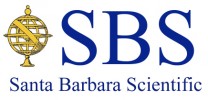History
The story of Santa Barbara Scientific is intimately associated with two former organizations through the participation in these groups by SBS founder and CEO, Michael Barber, and others who have been instrumental in the path leading to the creation of SBS:
1985 – 1989 Santa Barbara Astronomy Group
The history of SBS began about 13 billion years ago when some mysterious events created incredibly strong bursts of gamma rays. Skip ahead to about 3 decades ago when a group of four amateur astronomers got together to do some science in their spare time. This was the Santa Barbara Astronomy Group (SBAG). The purpose of the group was to look for optical counterparts to gamma ray bursts, known to exist at the time from data gathered by satellites that were originally designed only to monitor for treaty violations of above ground nuclear testing. The work of SBAG was recognized in the December, 1986, issue of Sky & Telescope. Michael Barber, Alan Holmes and Matt Longmire joined the group in 1986. Our work involved observing, in pairs, an error box provided to us by NASA known to contain a previous gamma ray burst. It was not known at the time if GRBs repeated (See articles from the Santa Barbara News Press and University of Calirornia at Riverside). In order to automate observing, we needed a tracking device that would keep the commercial telescopes we owned trained on the same spot for hours at a time, unattended. This need was the genesis of the ST-1, ST-2, ST-3 and ultimately the ST-4 autoguider, originally designed by Dr. Alan Holmes and tested during its development in Michael Barber’s observatory. Dr. Holmes already had experience in the design of CCDs imaging systems in his previous work at Santa Barbara Research and in the development of the SeaWIFs earth imaging satellite project. In order to sell the ST-4, we formed a corporation for commercial operations, Santa Barbara Instrument Group, Inc. (SBIG) in 1989. A page of slides illustrates this history in more datail. The results of our research was written up in an article published in The Astrophysical Journal, September, 1987.
1989 – 2014 Santa Barbara Instrument Group
SBIG was incorporated by Richard Schwartz, Jack Brooks, Michael Barber, Alan Holmes and Matt Longmire. Richard Schwartz, SBIG's first President, passed away in 1999. In 2000 Alan Holmes was appointed Presdient and Michael Barber was appointed Vice President. Both also continued to serve on the Board of Directors. Matt Longmire retired from the company and was replaced by Matt Thomas. At times during this period SBIG had up to 21 employees. The accomplishments and success of SBIG is well known in the world of astronomical imaging. A number of innovations helped to revolutionize astronomical imaging for amateurs. In this period SBIG designed, produced and sold over 3 dozen models of cameras, 17 models of filter wheel, 4 adaptive optic devices, 3 spectrographs, and numerous accessories. SBIG cameras can be found in the largest observatories in the world as well as some of the finest colleges and universities. Several patents, including Self-Guiding and Differential Guiding, and many firsts are in the SBIG list of accomplishments. In 1998 Sky & Telescope began granting vendors in the astronomy market "Hot Product" awards each year for new innovative products that advance the utility of amateur astronomy. Over the following 16 years, SBIG was granted a Hot Product designation 17 times. Another remarkable event was the selection, in 2005, of SBIG as the camera of choice for the Royal Observatory of King Rama IX, the King of Thailand and the appointment of Michael Barber as a special consultant with Khun Kriseeh Petchpornprapas, the representative of King Rama IX for the project. SBIG cameras were also chosen by Las Cumbres Observatory Global Telescope Network and once again SBIG was recognized in the local press. In 2011, SBIG was acquired by a Life Science company, Aplegen, Inc. Unfortunately, however, the management of the new organization was more familiar with the Life Science market than the astronomy market and it was eventually decided to sell SBIG, again, to a company more familiar with its place in the world of astronomical imaging. That company was Diffraction Limited in Canada.
2014 - Present - Santa Barbara Scientific
Santa Barbara Scientific (SBS) was established as an independent company in November, 2014, by Michael Barber, one of the co-founders and Vice President of Santa Barbara Instrument Group, Inc. (SBIG) for 25 years. Initially, the purpose of SBS was to assist in the transition period after the sale of SBIG to Diffraction Limited. In this role, Santa Barbara Scientific handled production of the larger format SBIG cameras and some specialty cameras and accessories under contract with Diffraction Limited. Additionally SBS handled all warranty and non-warranty repairs of SBIG products while Diffraction Limited got up to speed, eventually assuming production activity in Ottawa, Canada in 2015. From 2015 to 2017 SBS has marketed and sold several versions of a Seeing Monitor and provided a service for the refurbishment, certification and sale of used cameras. The current role of SBS (as of October 2017) is primarily to provide development and sales support for scientific imaging products using QHYCCD cameras. This relationship evolved from our use of QHY cameras in the SM-2 Seeing Monitor and our personal satisfaction with the products. For a more detailed history see the Company History page. For more information about QHY Products, please see our new QHY Product Information section.

 Seeing Monitors
Seeing Monitors